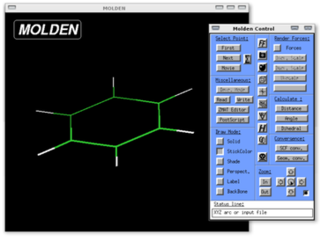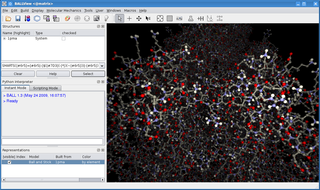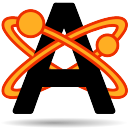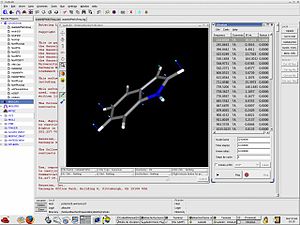GAMESS is a computational chemistry software program and stands for General Atomic and Molecular Electronic Structure System. The original Quantum Chemistry Program Exchange (QCPE) code of GAMESS split in 1981 and now the three version differ considerably:
Q-Chem is a general-purpose electronic structure package featuring a variety of established and new methods implemented using innovative algorithms that enable fast calculations of large systems on various computer architectures, from laptops and regular lab workstations to midsize clusters and HPCC, using density functional and wave-function based approaches. It offers an integrated graphical interface and input generator; a large selection of functionals and correlation methods, including methods for electronically excited states and open-shell systems; solvation models; and wave-function analysis tools. In addition to serving the computational chemistry community, Q-Chem also provides a versatile code development platform.
ScientificPython is an open source library of scientific tools for the Python programming language. Its development started in 1995.
MPQC is an ab initio computational chemistry software program. Three features distinguish it from other quantum chemistry programs such as Gaussian and GAMESS: it is open-source, has an object-oriented design, and is created from the beginning as a parallel processing program. It is available in Ubuntu and Debian.

Molden is a general molecular and electronic structure processing program.
MNDO, or Modified Neglect of Diatomic Overlap is a semi-empirical method for the quantum calculation of molecular electronic structure in computational chemistry. It is based on the Neglect of Diatomic Differential Overlap integral approximation. Similarly, this method replaced the earlier MINDO method. It is part of the MOPAC program and was developed in the group of Michael Dewar. It is also part of the AMPAC, GAMESS (US), PC GAMESS, GAMESS (UK), Gaussian, ORCA and CP2K programs.

Ghemical is a computational chemistry software package written in C++ and released under the GNU General Public License. The program has graphical user interface based on GTK+2 and supports quantum mechanical and molecular mechanic models, with geometry optimization, molecular dynamics, and a large set of visualization tools. Ghemical relies on external code to provide the quantum-mechanical calculations — MOPAC provides the semi-empirical MNDO, MINDO, AM1, and PM3 methods, and MPQC methods based on Hartree–Fock calculations.

PQS is a general purpose quantum chemistry program. Its roots go back to the first ab initio gradient program developed in Professor Peter Pulay's group but now it is developed and distributed commercially by Parallel Quantum Solutions. There is a reduction in cost for academic users and a site license. Its strong points are geometry optimization, NMR chemical shift calculations, and large MP2 calculations, and high parallel efficiency on computing clusters. It includes many other capabilities including Density functional theory, the semiempirical methods, MINDO/3, MNDO, AM1 and PM3, Molecular mechanics using the SYBYL 5.0 Force Field, the quantum mechanics/molecular mechanics mixed method using the ONIOM method, natural bond orbital (NBO) analysis and COSMO solvation models. Recently, a highly efficient parallel CCSD(T) code for closed shell systems has been developed. This code includes many other post Hartree–Fock methods: MP2, MP3, MP4, CISD, CEPA, QCISD and so on.
General Atomic and Molecular Electronic Structure System is computer software for computational chemistry program. The original code started on October 1, 1977 as a National Resources for Computations in Chemistry project. In 1981, the code base split into GAMESS (US) and GAMESS (UK) variants, which now differ significantly. GAMESS (US) is maintained by the members of the Gordon Research Group at Iowa State University. GAMESS (US) source code is available as source-available freeware, but is not open-source software, due to license restrictions.
General Atomic and Molecular Electronic Structure System (GAMESS-UK) is a computer software program for computational chemistry. The original code split in 1981 into GAMESS-UK and GAMESS (US) variants, which now differ significantly. Many of the early developments in the UK version arose from the earlier UK based ATMOL program, which, unlike GAMESS, lacked analytical gradients for geometry optimisation.
The fragment molecular orbital method (FMO) is a computational method that can compute very large molecular systems with thousands of atoms using ab initio quantum-chemical wave functions.

BALL is a C++ class framework and set of algorithms and data structures for molecular modelling and computational structural bioinformatics, a Python interface to this library, and a graphical user interface to BALL, the molecule viewer BALLView.
Firefly, formerly named PC GAMESS, is an ab initio computational chemistry program for Intel-compatible x86, x86-64 processors based on GAMESS (US) sources. However, it has been mostly rewritten, especially in platform-specific parts, mathematic functions, and quantum chemistry methods. Thus, it is significantly faster than the original GAMESS. The main maintainer of the program was Alex Granovsky. Since October 2008, the project is no longer associated with GAMESS (US) and the Firefly rename occurred. Until October 17, 2009, both names could be used, but thereafter, the package should be referred to as Firefly exclusively.

Molecular modeling on GPU is the technique of using a graphics processing unit (GPU) for molecular simulations.
CHELPG is an atomic charge calculation scheme developed by Breneman and Wiberg, in which atomic charges are fitted to reproduce the molecular electrostatic potential (MESP) at a number of points around the molecule.

Ascalaph Designer is a computer program for general purpose molecular modelling for molecular design and simulations. It provides a graphical environment for the common programs of quantum and classical molecular modelling ORCA, NWChem, Firefly, CP2K and MDynaMix . The molecular mechanics calculations cover model building, energy optimizations and molecular dynamics. Firefly covers a wide range of quantum chemistry methods. Ascalaph Designer is free and open-source software, released under the GNU General Public License, version 2 (GPLv2).

Avogadro is a molecule editor and visualizer designed for cross-platform use in computational chemistry, molecular modeling, bioinformatics, materials science, and related areas. It is extensible via a plugin architecture.
The Extensible Computational Chemistry Environment provides a sophisticated graphical user interface, scientific visualization tools, and the underlying data management framework enabling scientists to efficiently set up calculations and store, retrieve, and analyze the rapidly growing volumes of data produced by computational chemistry studies.
TeraChem is the first computational chemistry software program written completely from scratch to benefit from the new streaming processors such as graphics processing units (GPUs). The computational algorithms have been completely redesigned to exploit massive parallelism of CUDA-enabled Nvidia GPUs. The original development started at the University of Illinois at Urbana-Champaign. Due to the great potential of the developed technology, this GPU-accelerated software was subsequently commercialized. Now it is distributed by PetaChem, LLC, located in the Silicon Valley. The software package is under active development and new features are released often.







